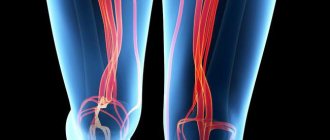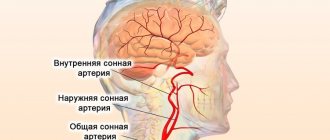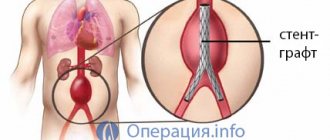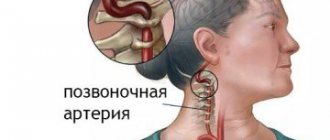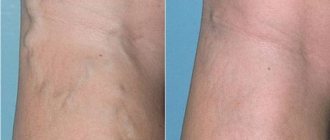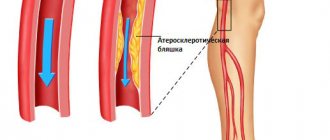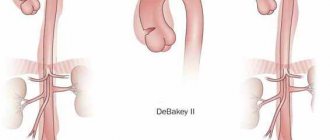Causes of femoral artery aneurysm
Two series of factors are recognized as triggers leading to the development of pathology. Among them are avoidable causes (smoking, various systemic and infectious diseases, unhealthy diet, joint injuries, vascular inflammation, surgical interventions in the pelvic area, high blood pressure) and disorders that modern medicine is not able to influence. Among the latter are age, hereditary predisposition, congenital anomalies and vascular dysfunction.
When considering the list of diseases that lead to the occurrence of an aneurysm, it is necessary to pay special attention to the most dangerous of them. According to medical research, in most cases the disease is a consequence of:
- tuberculosis;
- syphilis;
- atherosclerosis;
- hypertension.
False aneurysm of the popliteal artery is classified into a separate category. It develops after fractures, bruises, or poorly performed punctures.
An additional stimulating factor is injury to the knee joint.
The study of types of disease continues today. The reason for this is the lack of absolute clarity in the etiology of the disease.
Symptoms of aneurysm of the lower extremities
Among the structural pathological changes in our blood vessels, I would like to highlight a disease such as aneurysm. At its core, an aneurysm is a significant enlargement of a vessel in a separate area. Quite often, this pathology affects the vessels of our legs. The femoral and popliteal arteries are often affected. It is worth noting that the initial stages of aneurysm development are practically asymptomatic, which subsequently negatively affects the treatment of this disease. Any disease responds well to treatment in the early stages of its development, aneurysm is no exception. During its development, accompanied by expansion of the affected area of the vessel, a femoral artery aneurysm manifests itself as swelling in the groin area, cramps in the legs during physical activity, the appearance of ulcers on the toes, and numbness in certain areas of the legs. If left untreated, the symptoms become pronounced and intensify. Soft tissue necrosis is a common occurrence.
It is worth noting that the manifestation of symptoms is accompanied by pain of varying degrees of severity, sometimes pain is observed even at rest. Severe forms of the disease lead to the development of such irreversible complications as gangrene. It is hardly worth explaining that in this case there is a high risk of death.
The development of popliteal artery aneurysm is often caused by trauma. For most professional athletes, this is a fairly common disease. There is also a false form of the disease, the causes of which are bruises, fractures and unsuccessful surgical interventions. It is worth noting that a false aneurysm of the popliteal artery may be a consequence of a previous infectious disease.
- pain in the knee joint;
- a change in the shade of the skin, the skin becomes bluish in color;
- the temperature of the lower extremities differs significantly from the general body temperature, or, more simply, the legs become cold.
Aneurysm of the popliteal artery can lead to such serious complications as paralysis and complete immobilization of the limb. The most optimal treatment option is surgery, which can stop the progressive disease and prevent irreversible consequences. Among the most severe and often irreversible complications of aneurysms of the femoral and popliteal arteries, it is worth highlighting the development of gangrene as a result of a systematic lack of blood supply; rupture of an artery in the affected area, accompanied by heavy bleeding and hemorrhagic shock; the development of thrombosis arising as a result of atherosclerotic changes in the vessel.
Modern technologies make it possible to carry out treatment using a minimally invasive surgical method. The surgeon makes a small incision through which the stent is installed. The rehabilitation period after such an operation is considered short. Quite a long time ago, the method of vascular prosthetics began to be used. Its essence lies in excision of the affected area of the vessel and replacing it with a prosthesis. After the operation, normal blood circulation is restored and the danger of artery rupture disappears. Surgery to remove a false aneurysm is fundamentally no different from surgery for a true aneurysm.
Leg vascular aneurysm - Diseases
As a result of pathological changes occurring in the human body, the arterial system suffers. First, a slight expansion of the vessel walls occurs, and then a disease such as an aneurysm forms.
The disadvantage of this disease is that it is practically asymptomatic, which makes diagnosis very difficult. Aneurysms affecting the lower extremities are very common. As a rule, people who have passed the age of forty are susceptible to it. How to protect yourself from this disease and prevent it from developing, you can learn from this article.
Healthy and diseased vessel
The risk group for the disease includes older people. However, aneurysm of the lower extremities can also develop in the younger generation. Youth who lead an unhealthy lifestyle or have a history of serious illness should be on guard.
Causes of the disease:
- bad habits: drug addiction, alcoholism, smoking;
- inflammatory and infectious diseases affecting arterial walls: arteritis, vasculitis;
- hypertensive diseases;
- injuries or bruises in the knees or groin area;
- diseases affecting the cardiovascular system;
- poor nutrition;
- vascular injury.
An aneurysm is scary because during its development serious consequences can arise, leading to:
- thrombosis;
- gangrene of muscle tissue;
- aneurysm rupture;
- arterial insufficiency.
At the initial stage of development, vascular aneurysms do not manifest themselves at all. But after a while, when the artery begins to increase in volume, the patient may notice some signs of a femoral aneurysm:
- a slight swelling forms in the groin area, which is painful when palpated;
- during sports, short-term cramps appear in the lower extremities;
- while at rest, the patient feels slight discomfort in the legs;
- wounds or ulcers appear on the toes, when touched, acute pain appears;
- legs go numb.
Aneurysm of the femoral artery is also dangerous because there is a risk of complications. Considering that during the formation of the disease the immune system suffers, wounds on the body practically do not heal, which leads to the formation of gangrene, and then sepsis of the whole body.
A popliteal artery aneurysm develops in people actively involved in sports or heavy physical labor. The formation of the disease occurs due to constant non-healing injuries.
Symptoms of the popliteal artery:
- short-term pain is observed in the knee joint area;
- due to insufficient blood supply, bluish spots appear on the skin;
- there is coldness in the knee area;
- inability to move a limb.
Vascular aneurysm is considered an extremely dangerous disease, which, if not treated in a timely manner, can lead to the development of the following complications:
- Due to insufficient blood supply, gangrene develops, which leads to the removal of the limb. If amputation measures are not taken in time, gangrene can lead to infection of the entire body by pathogenic bacteria, which causes death.
- Due to unsuccessful therapeutic measures or puncture sampling, rupture of the artery walls may occur. This complication leads to internal bleeding. If bleeding is not stopped in time, hemorrhagic shock may occur.
- Atherosclerosis can cause thrombosis.
- Surgery performed on a femoral artery aneurysm can provoke myocardial infarction or coronary heart disease.
At the slightest suspicion of an aneurysm, you should consult a doctor to schedule an examination. Every person must remember that untimely detection of any disease can cause the development of pathological changes occurring in the body. Vascular aneurysm is a disease that requires strict control, high-quality diagnosis and proper treatment. The examination is carried out by a highly specialized specialist - a vascular surgeon.
For diagnostic examination the following are used:
- Ultrasound Doppler. This diagnosis combines standard ultrasound and Doppler scanning. With its help, you can see the movement of blood through the vessels, measure the speed of blood flow, determine the size of the vessels, and also identify possible blockage of the veins.
- Angiography. It is an x-ray examination and helps determine the correct functioning of the vascular system.
- MRI. Thanks to magnetic resonance imaging, the specialist receives a three-dimensional image, which, if desired, can be zoomed in to determine the condition of the vessels.
In some cases, the doctor may order a general blood and urine test. This is required in order to obtain an overall picture of the development of the aneurysm.
Aneurysm of the lower extremities is treated with surgery. The surgeon opens access to the damaged artery, excises a certain area, and then stitches it together. After the operation, the patient undergoes a rehabilitation period under the supervision of a doctor for some time.
After surgery, folk remedies will be no less useful. Medicinal herbs will strengthen the walls of blood vessels and ensure proper blood supply. However, herbs should be used only after consultation with a specialist. As a folk treatment, decoctions of Siberian elderberry or tinctures of dill are used.
It should be noted that traditional medicine cannot replace vascular surgery, so you should not ignore the recommendations of your doctor. There is no alternative treatment other than surgery, so delay can be fatal.
If you have been diagnosed with a lower extremity aneurysm, do not panic. Surgical treatment will allow you to live a full life, and not be in a state of fear.
Health disorder belonging to the group of diseases of the arteries, arterioles and capillaries
408,999 people diagnosed with aneurysm of the artery of the lower extremities
16,109 died with a diagnosis of Aneurysm of the artery of the lower extremities
3.94% mortality rate for the disease Aneurysm of the artery of the lower extremities
We will contact you as soon as we find a suitable specialist
Men are diagnosed with Aneurysm of the artery of the lower extremities. For 10,590 of them, this diagnosis is fatal.
mortality in men with the disease Aneurysm of the artery of the lower extremities
women are diagnosed with Aneurysm of the artery of the lower extremities. For 5,519 of them, this diagnosis is fatal.
mortality in women with the disease Aneurysm of the artery of the lower extremities
The disease most often occurs in men aged 65-69
In men, the disease is least common at age
In women, the disease is least common between the ages of 0-4
The disease most often occurs in women aged 65-69
Absence or low individual and social danger
* — Medical statistics for the entire group of diseases I72 Other forms of aneurysm
The cause of arterial obstruction in the vast majority of cases is atherosclerosis. These dysfunctions arise against the background of many provoking factors, among which there is a high percentage of related genetic and acquired pathologies.
Symptoms of diseases of the arterial system vary depending on the location of the lesion, but generally accepted warning signs include the following: Headaches and syncope (fainting); Increased fatigue; Insomnia (often due to pain); Jumps in blood pressure (attacks of hypertension and hypotension); Nausea and vomiting; Stool disorders (with damage to the intestinal arteries); Intermittent claudication; Pain in the affected area (at rest - inclusive); Numbness, tingling, burning, itching in the legs; Paleness, cyanosis, other changes in skin tone; A persistent sensation of strong pulsation in the diseased vessel (rare); Stable coldness of the extremities; Darkening or blackening of the skin; Formation of trophic ulcers; Necrotic skin changes and gangrene.
There is no standard for diagnosing the disease Aneurysm of the artery of the lower extremities
Diagnosis Aneurysm of the artery of the lower extremities is in 18th place in the frequency of diseases in the section DISEASES OF ARTERIES, ARTERIOLES AND CAPILLARIES
The most common:
Disease Aneurysm of the artery of the lower extremities is in 18th place in terms of the risk of diseases in the heading DISEASES OF ARTERIES, ARTERIOLES AND CAPILLARIES
The diagnosis is made based on the patient’s complaints and a combination of clinical symptoms. Laboratory diagnostic methods are also used.
* — Medical statistics for the entire group of diseases I72 Other forms of aneurysm
There is no standard for the treatment of lower extremity artery aneurysm disease.
Doctors need 8 days for hospital treatment
Less than an hour is required for outpatient treatment
0 medical procedures are provided for the treatment of the disease Aneurysm of the artery of the lower extremities
Lifestyle changes Undoubtedly, a very important stage of treatment is lifestyle changes. In this regard, the doctor may recommend the following to you: quit smoking if you are a smoker; optimize weight, diet and exercise regimen; Constantly monitor and adjust your blood pressure levels if you have high blood pressure; Manage your blood sugar levels with appropriate diet and treatment if you have diabetes. Drug treatment Depending on the situation, the doctor may prescribe treatment aimed at reducing pain, blood viscosity, normalizing cholesterol, blood pressure and glucose levels. Surgical treatment The choice of surgical treatment method depends on many factors: location, severity of the lesion, age. Artery bypass: bypassing a narrowed or completely blocked section of an artery, an additional path is created for blood flow - a shunt. One of your own veins or a prosthesis made of artificial material can be used as a shunt. Examples of such operations include the so-called aortofemoral, aortoiliac, iliofemoral, femorofemoral, femoropopliteal, femoro-tibial bypass. Arterial replacement: the damaged area of the artery is replaced with an artificial vascular graft. Endarterectomy and arteryplasty: an operation in which atherosclerotic plaque is removed through an incision in the artery to restore blood flow. For a better result, a special patch can be sewn between the edges of the arterial incision, thereby expanding the lumen of the artery.
Symptoms of an aneurysm
Clinical angiology indicates the presence of classic symptoms of the disease in 88% of patients from the total number of patients examined. The following symptoms are typical for a femoral artery aneurysm:
- acute pain, significant discomfort, subsiding at rest;
- the presence of a pulsating formation;
- impairment of motor functions of the affected limb.
The above triad of symptoms is often supplemented by a feeling of fullness at the site of expansion, increased fatigue, muscle weakness (up to the occurrence of partial paralysis), the appearance of cramps, local tissue cyanosis, pallor of the skin of the feet, and coldness of the legs.
The symptoms of a false aneurysm are similar to the signs of the disease in question. Its main manifestation is pain in the groin.
A medical examination reveals swelling in the affected area. The diameter of the formation varies from 2-3 to several tens of centimeters (the medical literature describes cases of aneurysm spreading to almost the entire limb).
You should know that the initial stages of the disease practically do not manifest themselves.
The above symptoms appear at the stage of active development of the disease.
Treatment
Therapy for pseudoaneurysm depends on the size of the hematoma, the location of its origin and the rate of its increase. Having carried out all the necessary examinations of the patient: ultrasound, angiography followed by the administration of a contrast agent. In medical practice, three treatment options for false aneurysm are used:
- compression if the aneurysm is small;
- a special drug is injected into the enlarged cavity, which has a thrombosing effect, that is, it blocks the movement of blood through the vessel;
- surgical intervention: open or endovascular (the operation is performed with miniature instruments). During open surgery, the aneurysm itself is removed and vessel replacement or cannulation is performed if necessary.
Each type of therapy has certain indications and contraindications and possible complications. Consequently, for each patient the doctor personally selects the necessary type of treatment.
How dangerous is the disease?
The main consequence of aneurysm of the vessels of the lower extremities is increased thrombus formation caused by slower blood flow in the deformed tissues. Pathology also leads to a decrease in the elasticity and strength of vascular walls. This influence, in turn, increases the risk of dissection and, in the future, rupture of the arteries.
The described complication - ischemia - is an extremely serious condition, the outcome of which (in the absence of timely treatment) can be amputation of a limb.
Among the dangers associated with the progression of the pathology, it is necessary to note the possible development of gangrene and thrombosis.
The appearance of blood clots is also observed with pseudoaneurysm. A false form of the disease can also provoke the occurrence of:
- suppuration in the affected area;
- sepsis;
- compression of nearby veins and nerve trunks.
All of the above diseases can cause serious harm to human health.
Classification of pathology
Aneurysms are classified according to different parameters. Taking into account the origin, doctors distinguish between congenital and acquired pathologies. However, congenital aneurysms are considered very rare. If they are detected, they are most often in the brain. Aortic aneurysm can be congenital.
An acquired increase in the lumen of a blood vessel appears under the influence of various pathological processes that arise both in the vascular wall itself and passing from neighboring tissues.
Taking into account the shape and affected vessels, the following types of aneurysm are distinguished:
- Saccular or saccular. It is distinguished by its large size and spherical shape. When such expansion occurs, a small area of the vessel is captured. Due to its large size, blood stagnates in it very quickly and a blood clot forms. The latter can fill most of the protrusion zone. There are several types of saccular aneurysm: funnel-shaped, spherical, cricoid. Causes of development: sepsis, syphilis, nodular periarthritis and trauma.
- Fusiform. Outwardly, it looks like a spindle. The expansion of the walls is symmetrical. It follows the course of a vein or artery. This pathology is often detected in the thoracic or abdominal part of the aorta. Sometimes it is found on the iliac artery.
- Cylindrical. This expansion is always symmetrical and occupies a large area of the vein or artery. In some cases, the length of the aneurysm may exceed 20 cm.
- Scaphoid. It got its name because it is shaped like a rook. The expansion covers a small area of the vascular wall.
- Anatomical or dissecting. It appears only in arteries and causes the vascular wall to divide into several layers. As a result, blood can move in 2 directions: through the anatomical lumen of the vessel and between the dissected walls. In some cases, such dissection leads to the formation of a hematoma communicating with the lumen of the vessel.
The classification takes into account the anatomical location of the affected vessel. Taking this characteristic into account, doctors distinguish the following types of pathology:
- Arterial. The name speaks for itself. The pathology affects only the arteries. Most often it occurs in the abdomen and chest.
- Venous aneurysm. This is quite a rare occurrence. Most often, pathology appears on the lower and upper extremities in certain places. For example, an aneurysm in the leg usually affects the popliteal veins, while in the arm it can affect the vessels of the forearm.
- Brain aneurysm. Enlargement of the lumen is usually found in the intracranial part of the carotid artery in the circle of Willis. At this point the carotid artery meets the internal one.
- Renal. It affects both the vessels of the organ parenchyma and the arteries supplying the kidneys themselves.
- Intestinal. It is often detected in the mesenteric artery emerging from the aorta in the area of the first lumbar vertebrae. The expansion of this vessel leads to disruption of the gastrointestinal tract, because it supplies the intestines with nutrition.
- Heart. Such an aneurysm develops on the coronary arteries and small vessels in the organ cavity. The likelihood of its occurrence increases greatly after a myocardial infarction.
By size, the expansion of the lumen of blood vessels is divided into small, medium and giant. In the first case, the diameter of the vascular wall protrusion zone does not exceed 11 mm, in the second it is between 11 and 25 mm, and in the third it exceeds 25 mm.
Based on the number of chambers, single-chamber and multi-chamber vascular aneurysms are distinguished.
Diagnosis of the disease
The difficulty of identifying aneurysms is explained by the lack of clinical signs in the early stages of disease development. Up to 80% of patients do not notice changes occurring in the body. About a third of patients consult a doctor 5 years after the expected date of onset of the pathology.
If abnormalities in the structure of blood vessels are detected at the primary stage, the doctor will choose a wait-and-see approach, which consists of regularly studying the condition of the affected artery using ultrasound scanning.
Diagnosis of progressive forms of the disease is based on the results of the examination. Identification of a pulsating formation located in the groin area is the basis for a number of additional studies, including:
- angiography;
- MRI;
- CT scan.
To clarify the etiology of the aneurysm, the subject of study will be the body fluids (blood, urine) of the sick person.
Treatment of aneurystic pathologies in the legs
Conservative therapy is not used to relieve the disease. Elimination of formations requires the use of various surgical procedures, the type of which is selected taking into account the stage of the disease.
There are two methods of surgical treatment:
- Prosthetics based on replacing affected areas of arteries. To carry out the procedure, a synthetic product or a shunt (a fragment of a vein) removed from the patient’s healthy limb is used. The method is a highly effective method for relieving the disease and is used in 50% of treatment cases.
- Ligature application. The manipulation in question consists of ligating the affected artery below and above the detected area of violation. The blood flow is redistributed to adjacent small vessels, and the area fixed in the above manner is removed. The operation is characterized by a low level of trauma (compared to the previous method).
Complications
When treating a pseudoaneurysm, distal embolism and pulmonary embolism may occur. The reason for the development of complications is the penetration of the medication used into the main vessel.
The negative consequences of aneurysm of the femoral arteries (in the absence of timely treatment) include:
- stagnation of body fluids (lymph, blood);
- the appearance of trophic ulcers;
- tissue necrosis;
- leg paralysis
A negative result of surgical procedures can be a heart attack or coronary artery disease.
The outcome of most of these complications is gangrene and subsequent amputation of the affected limb.
It should be remembered: going to the clinic in the early stages of the disease will allow you to avoid complex concomitant pathologies and maintain health.
